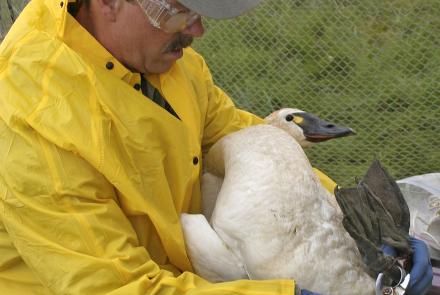Alaska's Coal
A few years ago, estimates of Alaska's coal resources placed them at approximately 130 billion tons. Now, largely because of better knowledge about the coal beneath the North Slope and the offshore area beyond, the estimates range from 1,860 billion to 5,000 billion tons.
This, of course, is a huge energy resource if it could all be recovered for use. Full recovery is unlikely because much of the coal is deeply buried, of not the best quality or is at locations where transportation is lacking.
In estimating what portion of an identified coal resource is recoverable, experts considering reserves elsewhere in the United States pick figures ranging from one percent to over twenty percent. And that percentage generally is applied only to known resources, not those which are hypothesized to exist on the basis of surface outcrops or sparse drilling information. Nor does the percentage apply to resources speculated to exist, such as off Alaska's northern coast, on the basis of even less information. The 1,850 billion to 5,000 billion ton estimate for Alaska includes these hypothesized or speculated resources.
But suppose Alaska really does have a coal resource amounting to the lower figure, 1,850 billion tons, and suppose that 10% of it is recoverable. That means Alaska could recover 185 billion tons. At the rate Alaska used energy in 1979, this is enough coal to last the state more than 15,000 years, leaving nothing for export.
Strangely enough, there is but one operating coal mine in Alaska. The Usibelli Coal Mines at Healy produce about 700,000 tons of coal annually. This coal supplied only 6% of the energy used in the state during 1979.
Alaska's lack of operating coal mines is not because people haven't tried. The Russian-American Company opened Alaska's first coal mine in 1855 at Port Graham, a locality on the Kenai Peninsula that had been discovered as early as 1786. The company built a small town on the site and after a year's work exported 88 tons of coal to California. The export venture failed because the coal could not compete with that obtainable from Canada, Australia, England and Chile. Though the mine did supply Russian ships for some years, the company gave it up as a bad show and threw in the towel in 1865.
Since then, dozens of Alaskan coal mines have opened. Most closed shortly thereafter, although some hung on for years. Demon petroleum bedeviled most of the operations. As early as 1902, steamers plying the Yukon River were converting from wood and coal to petroleum. The U.S. Navy, always in the vanguard, followed suit twenty-two years later. Finally, in 1946, even the Alaska Railroad changed over, despite the abundance of coal practically alongside the track and the fact that the railroad was built where it is in the first place because of the coal.
Another significant factor in the slow development of Alaska's huge coal resources is the quality of the coal itself. Most of the world's really good bituminous and anthracite coals have their origins in terrestrial plants that grew 300 million years ago, during the Garboniferous (Mississippian and Pennsylvanian) period. Burial under overlying sediments brought high temperatures and pressures acting over a long period of time to develop high-quality coals.
Unfortunately, most of Alaska's coals are much younger. They were primarily born in the more-recent Cretaceous and Tertiary periods, 30 million to 130 million years ago. Many of these younger Alaskan coals haven't cooked long enough at sufficiently high temperature (100° to 400°C) to coalify into the high-quality bituminous and anthracite coals most desired. The majority of the Alaskan coal is lignite, sub-bituminous and bituminous.




